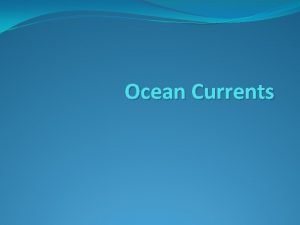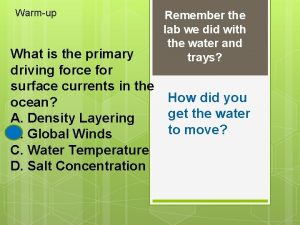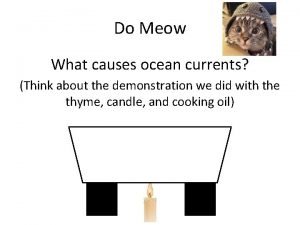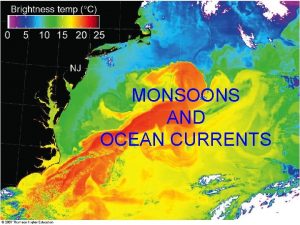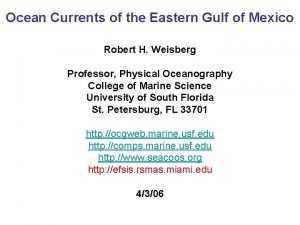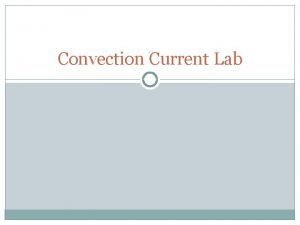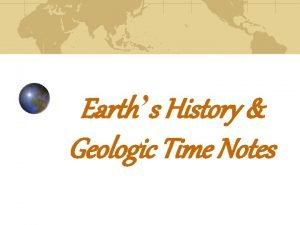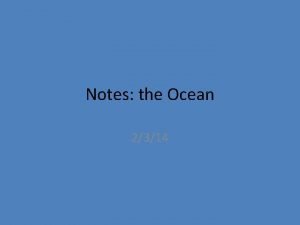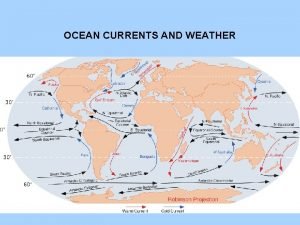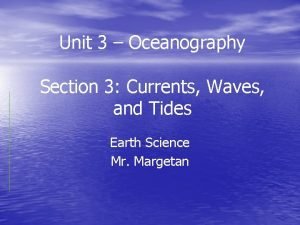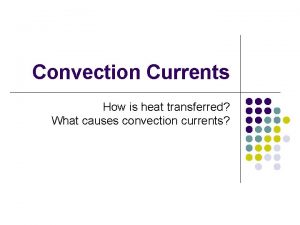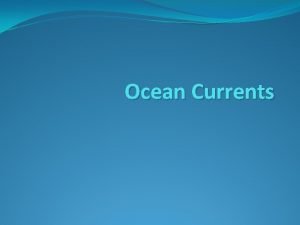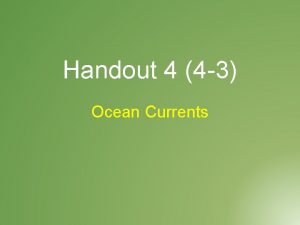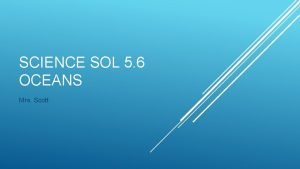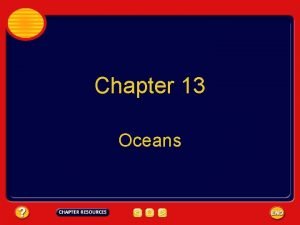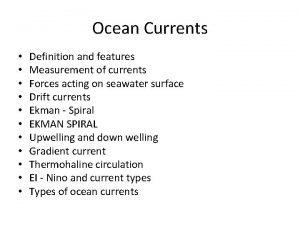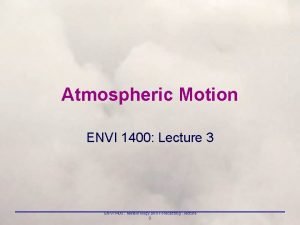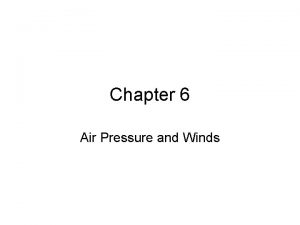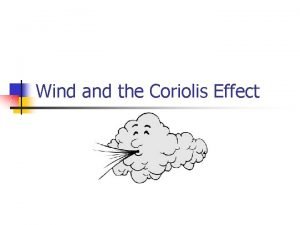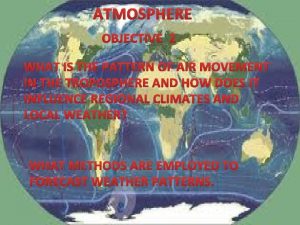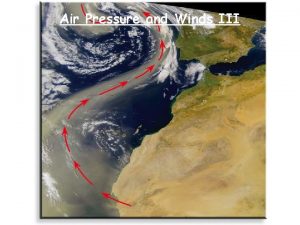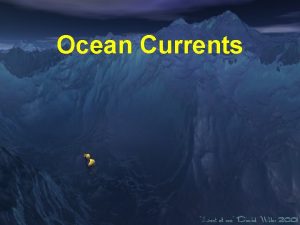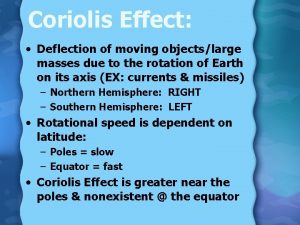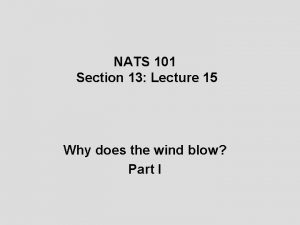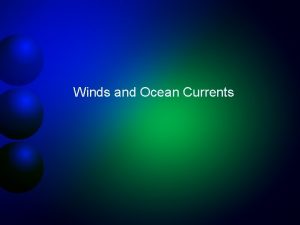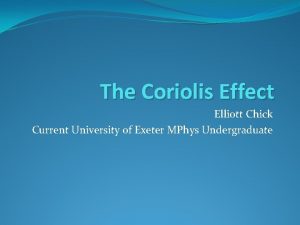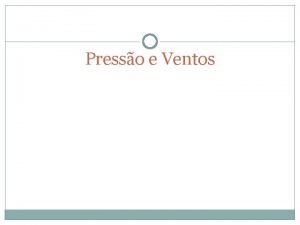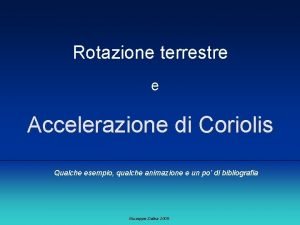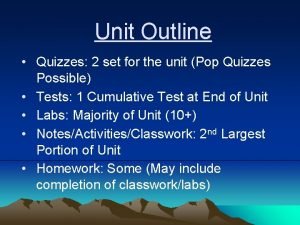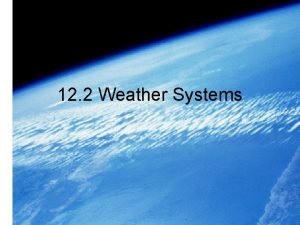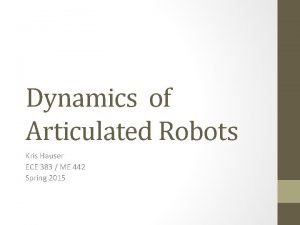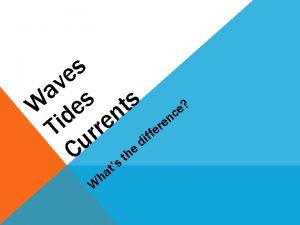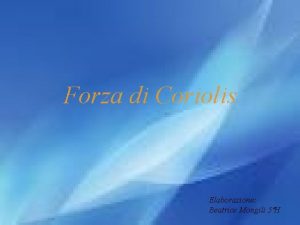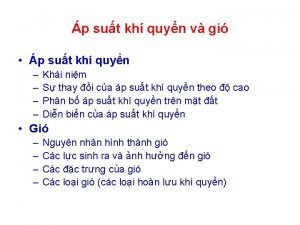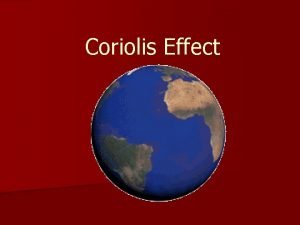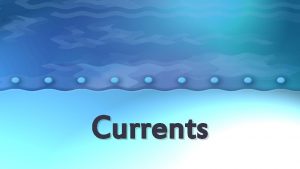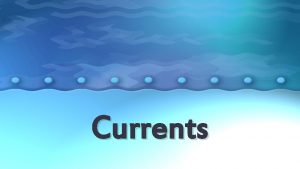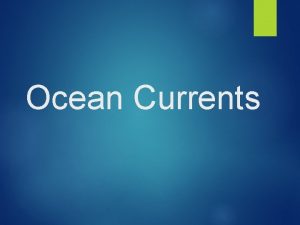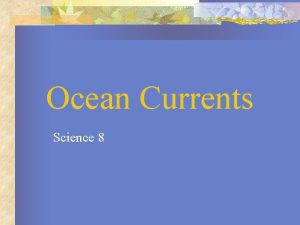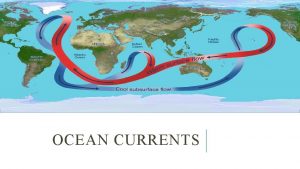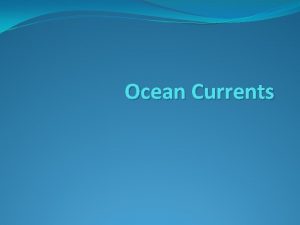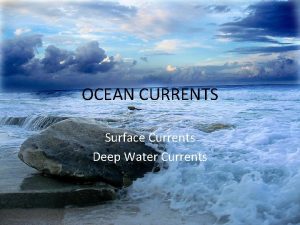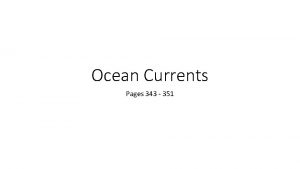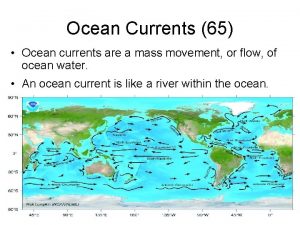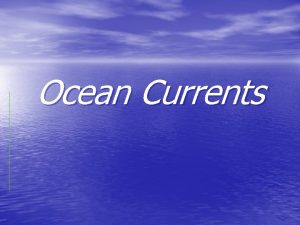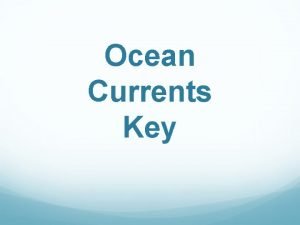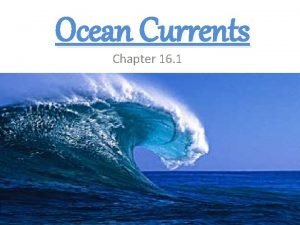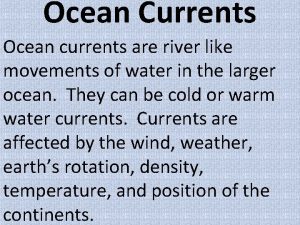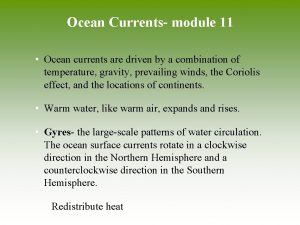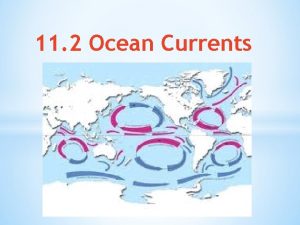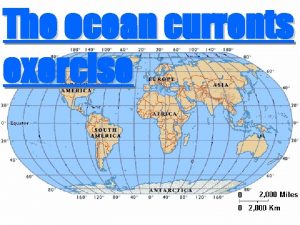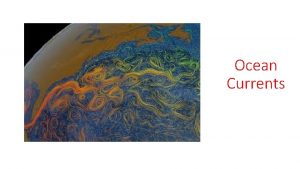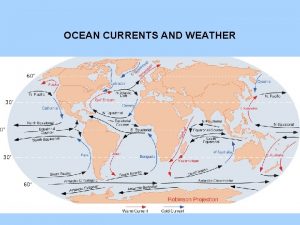Ocean Currents The Coriolis Force The Coriolis force
















































- Slides: 48

Ocean Currents

The Coriolis Force The Coriolis force deflects objects (wind) moving toward the Equator to the west The Coriolis force deflects objects (wind) moving toward the poles to the east.

The Coriolis force deflects objects (wind) moving toward the Equator to the west The Coriolis force deflects objects (wind) moving toward the poles to the east. 60 o 30 o 0 o

Ocean Currents

Ocean Surface Temperature 40 o F 90 o F 40 o F

Ocean Currents Surface Currents The upper 400 meters of the ocean (10%). Deep Water Currents Thermal currents (90%)

Surface Currents Forces 1. Solar Heating (temp, density) 2. Winds 3. Coriolis

Solar Heating and Density Mass Volume (g) (cm 3)

High density 4 D=m V Expanding water (increasing volume) low density Ice density Water expands as it is heated.

Solar Heating Heat expands water near the Equator equator N S

General Circulation pole Ocean equator Earth Sun’s rays

General Circulation (North) Surface Water

Winds Guide the Direction of Surface Water Winds blow eastward between 0 o and 30 o latitude. Rotation 30 o 0 o 30 o

General Circulation (North) wind Surface Water

The Coriolis force deflects objects moving toward the poles to the east.

Winds plus Coriolis Force East wind

Winds plus Coriolis Force The Coriolis force deflects objects moving toward the poles to the east. West wind East wind

Circulation The Coriolis force deflects objects (wind) moving toward the Equator to the west West wind East wind

Atlantic Gyre

Gyres Clockwise current in Northern Hemisphere Counter clockwise current in S. Hemisphere

Temperature/Energy Transfer Heat Capacity cool warm cool

Heat Capacity = 1 cal/go. C

Deep Water Currents

Deep Water Currents 300 ft Low density 3000 ft 1. Temperature 90% total volume 2. Density High density

General Circulation pole Ocean equator Earth Sun’s rays

Rising and Sinking pole Equator Density Sinking

Thermal Conveyor Red = surface Mixing time of the Atlantic ocean: 1000 years

Two Major Currents Gulf Stream Humbolt Current

The Gulf Stream 1769

The Gulf Stream “a river in the ocean” 1000 x more water transported than the Mississippi. 20 – 40 miles wide ½ mile deep 4 miles per hour


Ireland England Spain cornwall

The Humbolt (Peru) Current

The Humbolt (Peru) Current

Easterlies desert Cool water Cool air Westerlies 7 -8 C° cooler than the ocean at similar latitudes Dry conditions near the coast.

Upwelling productive Nutrient Source for Food Web Basis for a rich fishing industry off Peru. wind

Surge of Nutrients: Food Chain Phytoplankton constitute the food base of all marine animals, are microscopic organisms that inhabit only the sunlit uppermost oceanic layer, using sunlight to photosynthetically combine carbon dioxide and dissolved nutrient salts. Zooplankton marine animals that rely mainly upon water motion for transport. Zooplankton subsist on phytoplankton and smaller zooplankton. Nekton free swimmers, are dominated by the bony and cartilaginous fishes, molluscans, and decapods, with rarer mammals and reptiles.

Normal Conditions ½ meter Warm water Moist air High ppt. Cool water Dry air Low ppt.

Abnormal Conditions

Sustained Abnormal Conditions Rain in desert areas Warm water surge

Abnormal Conditions El Niño: Spanish name for the male child Sustained sea surface temperature anomalies across the central tropical Pacific Ocean. Initially referred to a weak, warm current appearing annually around Christmas time along the coast of Ecuador and Peru and lasting only a few weeks to a month or more.

El Niño

Local Consequences (East) normal High Nutrient Levels El Nino Low Nutrient Levels

Other Consequences Droughts Fires Indonesia Australia Floods Mosquitoes Disease Peru Chile Interior

El Niño is driven by slackening of easterly winds off the coast of Peru. This results in less upwelling of cool nutrient-rich water. Persistent El Niño allows warm moist air to persist near Peru leading to high rainfall in an area that typically receives little rain. Conversely, Australia and Indonesia experience drought.



Surface currents are driven by solar heating, winds and the Coriolis force These forces produce gyres that rotate clockwise in the N. hemisphere. The Gulf Stream is off the coast of N. America flowing toward Europe. It bring warm waters to the north attenuating the effects of latitude. The Humbolt current is off the West coast of S. America It brings cool, nutrient-rich water northward. Easterly wind off Peru push water away from the coast producing upwelling. The general result is high nutrient contents and cool water near Peru. The water is warmed as it moves west eventually supplying warm water
 Coriolis force effect on ocean currents
Coriolis force effect on ocean currents What is the primary driving force of surface-ocean currents
What is the primary driving force of surface-ocean currents What is a deep current
What is a deep current What are ocean currents
What are ocean currents Ocean currents
Ocean currents Ocean currents gulf of mexico
Ocean currents gulf of mexico Convection current lab
Convection current lab What are the factors affecting the climate
What are the factors affecting the climate Cenozoic mammals
Cenozoic mammals Ocean currents waves and tides
Ocean currents waves and tides What are ocean currents
What are ocean currents Ocean currents and weather
Ocean currents and weather What causes wind to blow brainpop
What causes wind to blow brainpop Ocean currents
Ocean currents What causes convection currents in the ocean
What causes convection currents in the ocean Ocean currents vocabulary
Ocean currents vocabulary Ocean currents map
Ocean currents map Ocean currents
Ocean currents Cold peruvian current
Cold peruvian current Rubber ducks ocean currents activity
Rubber ducks ocean currents activity What are ocean currents
What are ocean currents Coriolis force
Coriolis force Buys ballot law diagram
Buys ballot law diagram What is coriolis effect caused by
What is coriolis effect caused by Coriolis force
Coriolis force Geostrophic wind
Geostrophic wind Ekman transport
Ekman transport Coriolis effect animation
Coriolis effect animation Wind pressure gradient
Wind pressure gradient Why coriolis force is zero at equator
Why coriolis force is zero at equator Ocean ocean convergent boundary
Ocean ocean convergent boundary Seafloor spreading demonstration
Seafloor spreading demonstration Convergent plate boundaries
Convergent plate boundaries Convergent oceanic oceanic plate boundary
Convergent oceanic oceanic plate boundary Ocean ocean convergent boundary
Ocean ocean convergent boundary Red ocean vs blue ocean
Red ocean vs blue ocean Types of divergent plate boundary
Types of divergent plate boundary Nekton include all animals that
Nekton include all animals that Coriolis
Coriolis Força de coriolis ventos
Força de coriolis ventos Solidi di rotazione animazione
Solidi di rotazione animazione Quizzes
Quizzes Narrow region separating two air masses
Narrow region separating two air masses The coriolis effect provides evidence that
The coriolis effect provides evidence that Coriolis matrix
Coriolis matrix Coriolis
Coriolis Forza di ferrel
Forza di ferrel Lực coriolis
Lực coriolis Efecto coriolis
Efecto coriolis
